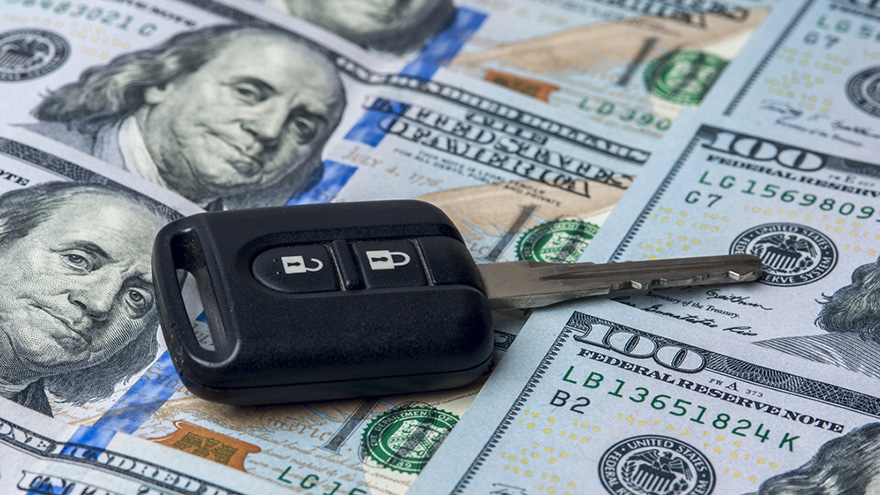For finance companies that like to book as much used-vehicle paper as they can originate, the latest Experian data shows institutions are not having to take on as much risk to fill that portion of their portfolio objectives.
Findings from the Q1 2019 State of the Automotive Finance Market report showed that the percentage of consumers choosing used vehicles reached all-time highs. Analysts noticed the figure for prime hit 61.88 percent, and the super-prime reading reached 44.78 percent.
Experian explained in a news release distributed on Thursday morning that this trend comes as questions around vehicle affordability continue to dominate industry conversations.
The average amount financed for a new vehicle surpassed $32,000 in Q1, while the average amount financed for a used vehicle was slightly above $20,000. Additionally, the average monthly payment for a new vehicle was $554, and the average monthly payment for a used vehicle was $391.
“While vehicle affordability continues to be top of mind for the industry, consumers are actively seeking ways to ensure they can afford the vehicle they purchase — a positive sign for all parties involved,” said Melinda Zabritski, Experian’s senior director of automotive financial solutions.
“It’s important that lenders and dealers continue to monitor these trends so they can work with car shoppers to help them find the right vehicle with the right financing options,” Zabritski continued.
The other side of the affordability conversation has focused on delinquency trends.
In Q1, Experian reported 30-day delinquencies saw an increase to 1.98 percent, up from 1.9 percent a year ago. That said, banks, credit unions and finance companies all saw slight decreases in 30-day delinquency rates, and 60-day delinquencies remained relatively stable at 0.68 percent year-over-year.
Zabritski pointed out that it’s important to keep in mind that the 30-day delinquency rate is still below the high-water mark in Q1 2009 when it soared to 2.81 percent during the Great Recession.
“The delinquency rate is certainly a trend worth keeping an eye on, but it’s important to consider it within the larger historical context,” Zabritski said. “Other factors, like subprime originations remaining at historic lows, help paint the full picture of the industry.”
Experian mentioned additional findings for Q1 included:
• Outstanding automotive balances totaled $1.181 billion.
• The percentage of outstanding loan balances held by subprime and deep-subprime consumers dropped below 19% (18.77%).
• Credit scores remained stable, with some improvement seen in used, which increased from 655 to 657 year-over-year. The average new credit score (719) is the same as Q1 2018.
• Average new loan terms decreased to 68.85 months, while average used loan terms increased to 64.67 months.
• The percent of used vehicles that are leased saw a slight year-over-year increase from 4.01% in Q1 2018 to 4.68%.
• The gap between the average new and used monthly payments continued to widen, reaching $163.
Credit Acceptance Corp. created a new executive position this week and appointed an individual who has been with the company for 17 years to the position.
According to a filing with the Securities and Exchange Commission posted on Thursday, Credit Acceptance named Jonathan Lum as chief operating officer. Lum has been with the company since 2002 in a number of roles, starting in the finance department and moving up to accounting manager before being promoted to director of projects and support in 2007 and director of policy compliance in 2008.
Credit Acceptance promoted Lum to vice president of internal audit and compliance in 2009 and then to his most recent role of senior vice president of the dealer service center in 2011.
The executive move comes after Credit Acceptance finished the first quarter with consolidated net income of $164.4 million, or $8.65 per diluted share, representing a rise from $120.1 million, or $6.17 per diluted share for the same period in 2018.
The company reported its adjusted net income, a non-GAAP financial measure, for the three months that ended March 31 came in at $153.6 million, or $8.08 per diluted share, up from $118.9 million or $6.11 per diluted share a year earlier.
Credit Acceptance generated those Q1 figures even as originations remained nearly flat year-over-year. The company booked 112,844 contracts in Q1, up from 112,345.
The company’s active dealer network did rise by a notable amount in Q1. Credit Acceptance’s collection of stores that receive funding for at least one contract per quarter rose 9.9% year-over-year to 9,633.
“I think the first quarter is usually a good quarter for enrolling new dealers. We have a larger sales force than we had a year ago. So those are probably a couple of reasons why new dealer enrollments were pretty good,” Credit Acceptance chief executive officer Brett Roberts said during the company’s latest conference call.
“In general, our program works very well at a small independent dealer. It works very well with a larger franchise dealer. Sometimes the selling process can be different,” Roberts added later in the call. “The larger organizations typically there’s more people that need to sign off on a new lender, so it could be a little bit more complex. And then when you get into stores that have multiple locations and maybe a corporate office, there’s another selling process that occurs there. But other than that, the program works in all kinds of environments.”
SubPrime Auto Finance News put Brian Landau on the spot a bit after TransUnion released its latest auto-finance data. The senior vice president and automotive business leader pondered the question about which of these milestones might happen first. Will the market surpass 100 million outstanding vehicle leases and installment contracts, or will the average auto debt per consumer surpass $20,000?
During a phone conversation this week, Landau divulged that the number of consumers already currently holding some form of auto financing is approaching 90 million, which is up from the 82.2 million that TransUnion officially reported as of the close of the first quarter. Landau explained that metric moving higher is “heavily reliant on just the growth of the population. The market is fairly saturated. Every household has at least one car today. I don’t expect that to grow any faster than the rate of population, to be honest.”
With those thoughts in mind, Landau suspects that the average amount of auto debt consumers are carrying could surpass $20,000; perhaps in the not too distant future, since TransUnion pinpointed the average figure at $18,845 as of the close of Q1.
“I will say that there are some drivers in place now to grow the average transaction price; the shift to SUVs from sedans and SUVs typically have a larger price tag,” Landau said. “In addition, people are looking at vehicles as an extension of the Internet-of-Things (IoT), connecting to their phones and other electronics. That’s going to add a higher and heftier price tag to the purchase.”
TransUnion reported that auto originations grew 1.7% in Q4 2018 and have grown year-over-year in each of the past four quarters, reversing the negative trend caused by the pullback in the market the second half of 2016 and full-year 2017. Landau pointed out that super prime and subprime borrowers led this growth, with Q4 2018 year-over-year increases of 5.2% and 4.4%, respectively.
“When we look at origination growth in those two segments (super prime and prime), they’ve been pretty consistent,” Landau said. “There has been positive growth for some time now, even during the pullback. My perspective is that as the lenders in the market were being cautious during the pullback period, there was a flight to safety to those segments of the market. Low delinquency and the need to grow the book profitably have driven a lot of the growth on that end of the spectrum. I’m not surprised. That’s been consistent with what we’ve seen over the last few quarters and for some period of time now.
“On the subprime segment, we’ve actually seen some large gains relative to what the origination growth was during the pullback,” he continued. “It seems like there is a little bit of a whip-saw effect going on in the subprime segment. I think that is due to the fact that lenders are feeling much more confident in this area of the credit spectrum, more than they did in 2016 and 2017. In fact, if we go back to Q2 (of last year), we start to see that positive gain exceeding 5% year-over-year relative to what it was just a year prior when it was 10% or more down year-over-year. That’s a large gain from the low end being down 10% to the upswing of positive 5% in the course of a four-quarter timeframe.”
Meanwhile, TransUnion determined serious borrower delinquency rates (60 days or more past due) continued to remain stable at 1.31% in the first quarter. Q1 2019 was the seventh consecutive quarter with a year-over-year delinquency variation of less than 10 basis points.
Landau closed by reiterating how stable the auto-finance market is as a maelstrom of media coverage is swirling and stemming from other parts of the credit world.
“There is a lot of clamor around other parts of financial services particularly around student lending, but auto is the third largest asset class before mortgage and student lending. And it is one of the most secure, having one of the lowest delinquency rates of all asset classes out there, second only to (home equity lines of credit). And it’s one of the fastest growing segments within financial services, second only to personal lending, which has been driven primarily by the fintech boom,” Landau said.
Q1 2019 Auto Loan Trends
|
Auto Lending Metric
|
Q1 2019
|
Q1 2018
|
Q1 2017
|
Q1 2016
|
|
Number of Auto Loans
|
82.2 million
|
79.7 million
|
76.4 million
|
72.2 million
|
|
Borrower-Level Delinquency Rate (60+ DPD)
|
1.31%
|
1.32%
|
1.30%
|
1.16%
|
|
Average Debt Per Borrower
|
$18,845
|
$18,581
|
$18,386
|
$18,065
|
|
Prior Quarter Originations*
|
6.7 million
|
6.6 million
|
6.7 million
|
6.7 million
|
|
Average Balance
of New Auto Loans*
|
$22,128
|
$21,678
|
$21,071
|
$20,598
|
*Note: Originations are viewed one quarter in arrears to account for reporting lag. Source: TransUnion.
The latest auto-finance information available from Equifax revealed trends that made the company give bullish projections of what the subprime slice of the market might be like for the rest of the year.
Equifax’s auto-loan originations observations through January reported as of March indicated that 1.78 million contracts, totaling $41.3 billion, have been originated year-to-date. This data marks a 0.8% increase in accounts and a 2.8% increase in balances over this time last year.
The credit bureau noted auto loans represent 86.5% of all auto account originations and 89.5% of auto origination balances year-to-date.
Analysts tabulated that 379,100 auto loans have been originated year-to-date to consumers with a VantageScore 3.0 credit score below 620, which are generally considered subprime accounts. Equifax determined this figure represented a 1.9% increase from January 2018.
The company computed these newly issued subprime contracts have a corresponding total balance of $7.07 billion, a 5.3% increase year-over-year.
Through January, Equifax found that 21.3% of auto contracts were issued to consumers with a subprime credit score, and they accounted for 17.1% of origination balances. In 2018, year-to-date, the account share was 20.7%, and balance share was 16.4%.
Analysts went on to mention the average origination amount for all auto loans issued in January 2019 was $23,464. This figure marked a 3.3% increase over January 2018.
Equifax added the average subprime contract amount was $18,934. This figure is a 5.0% increase compared to January of last year.
“While subprime origination activity and balances remain steady and in check, the data is showing an increase entering the year,” said Jennifer Reid, Equifax’s vice president of automotive marketing and strategy.
“Prices on new cars and trucks continue to rise, but I think we’re seeing more evidence through subprime numbers that there is continued interest and activity in used vehicles for 2019,” Reid continued. “We anticipate this will persist in the coming months.”
Update on leasing
Equifax also discussed how the leasing market is performing through January and reported as of March.
Analysts found that 279,400 auto leases, totaling $4.8 billion, have been originated year-to-date. This is a 3.4% decrease in accounts and a 3.0% increase in balances from this time last year.
Equifax pointed out auto leases accounted for 13.6% of all auto accounts originated through January and 10.5% of balances.
The credit bureau also learned that 25,000 auto leases have been originated year-to-date to consumers with a VantageScore 3.0 credit score below 620, which again are generally considered as subprime accounts. That amount represented a 3.3% decrease from January of last year. These newly issued leases have a corresponding total balance of $462.1 million, a 4.6% increase year-over-year.
Through January, Equifax determined 8.9% of auto leases were issued to consumers with a subprime credit score. Through January of last year, the company said the share was the same.
Finally, the average origination balance for all auto leases issued in January was $17,137, according to Equifax. This amount marked a 5.7% increase from last January. The average subprime lease amount was $18,150, a 6.3% increase over a year ago.
“Note that lease origination values reflect the contract amounts only and exclude expected vehicle residual values,” Equifax said.
With Cox Automotive experts suspecting that “credit will likely tighten as the appetite for subprime declines,” the company also shared the makes that have the largest penetration of subprime retail installment contracts and vehicle leases so far this year.
Cox Automotive chief economist Jonathan Smoke reviewed the much-publicized data recently released from the Federal Reserve Bank of New York that generated so much attention because it showed more than 7 million contract holders were in delinquency. Smoke shared his assessment first in this Weekly Summary and then expanded in exclusive analysis shared with SubPrime Auto Finance News beneath a title line that read, “Credit will likely tighten as the appetite for subprime declines.”
Smoke continued, “Year-over-year, the number of severe delinquent accounts is up 4.4 percent. Subprime auto loan delinquencies increased much more, as the number of subprime severe delinquent accounts is up 5.9 percent.
“The subprime severe delinquency rate on auto loan accounts was 5.14 percent, which was the highest rate for any December since the Great Recession,” he noted.
“The auto delinquency problem is mainly in subprime as subprime severe delinquencies represent 69 percent of severe delinquencies, yet subprime accounts only represent 20 percent of active auto loan accounts,” Smoke went on to say.
So which brands might be most connected to those subprime contracts that could be in peril? According to data fueled by Dealertrack, here are the badges with the leading amounts of subprime market penetration:
1. Mitsubishi
2. Dodge
3. Fiat
4. Chevrolet
5. Buick
6. Toyota
7. Chrysler
8. Honda
9. RAM
10. BMW
A quartet of analysts took a deep look at the auto finance data after the Federal Reserve Bank of New York’s Center for Microeconomic Data released its Quarterly Report on household debt and credit on Tuesday.
At first blush, it might look inflammatory that the New York Fed data fueled by Equifax showed that more than 7 million people had an auto finance contract at least 90 days delinquent by the time 2018 finished. However, the data set also pointed out that more than 89 million people have some form of auto financing — a lease or retail installment contract. That’s the highest figure ever recorded, according to the Fed data from Equifax that goes back to 1999.
All told, auto financing surged by $53 billion year-over-year to close 2018 at $1.27 trillion; again the highest figure ever recorded.
While perhaps collection departments, forwarding companies and repossession agents will see a surge of activity this year, New York Fed experts offered some clarity. Andrew Haughwout, Donghoon Lee, Joelle Scally and Wilbert van der Klaauw collaborated on the Federal Reserve Bank of New York Liberty Street Economics blog for a post titled, “Just Released: Auto Loans in High Gear.”
They wrote, “After years of growth among borrowers across the credit score spectrum, 2018’s strength in auto loans was primarily driven by those originated by the most creditworthy individuals, while originations to those with scores below 720 have leveled off, albeit at high volumes. The high volume of prime originations has caused a quality-shift in the outstanding pool of auto loans and, as of the fourth quarter of 2018, 30 percent of the $1.27 trillion in outstanding debt was originated to borrowers with credit scores over 760.
“Meanwhile, the share of total auto loans outstanding that was originated to subprime borrowers fell to 22 percent. In fact, these percentages would suggest that the overall auto loan stock is the highest quality that we have observed since our data began in 2000,” they continued.
“However, with growth in auto loan participation, there are now more subprime auto loan borrowers than ever, and thus a larger group of borrowers at high risk of delinquency,” the experts went on to say.
The report went on to mention that auto financing is just part of what’s pushing overall debt to new highs.
The report showed that total household debt increased by $32 billion (0.2 percent) to $13.54 trillion in the fourth quarter of 2018. It was the 18th consecutive quarter with an increase, and the total is now $869 billion higher than the previous peak of $12.68 trillion in the third quarter of 2008.
Furthermore, analysts found overall household debt is now 21.4 percent above the post-financial-crisis trough reached during the second quarter of 2013.
The report is based on data from the New York Fed’s Consumer Credit Panel, a nationally representative sample of individual- and household-level debt and credit records drawn from anonymized Equifax credit data.
Haughwout, Lee, Scally and van der Klaauw acknowledged that auto finance delinquency rate of 2.36 percent as of the end of 2018 is much higher than the reading of 1.5 percent seen in 2012. But they also viewed it in the context of how many vehicles have rolled over the curb, filling finance company portfolios during that span.
“The surging auto loan industry has been on our radar for more than five years now. But, the level of loan originations has been commensurate with auto sales, with a steady 50 to 60 percent financing share of combined new and used vehicle purchases — a percentage surprisingly stable in our sample period, which suggests that car loans have been tracking the growth seen in motor vehicle sales,” they wrote in the blog.
“Although rising overall delinquency rates remain below 2010 peak levels, there were over 7 million Americans with auto loans that were 90 or more days delinquent at the end of 2018. That is more than a million more troubled borrowers than there had been at the end of 2010 when the overall delinquency rates were at their worst since auto loans are now more prevalent,” they continued.
“The substantial and growing number of distressed borrowers suggests that not all Americans have benefitted from the strong labor market and warrants continued monitoring and analysis of this sector,” they concluded.
All of the metrics Westlake Technology Holdings shared about its 2018 performance headed in directions that would please just about any executive team or board of directors.
And the company already is aiming for double-digit improvement this year.
The company recently announced its portfolio grew 35 percent in 2018, finishing at an all-time high of $8.33 billion in assets under management. Executives highlighted that core automotive indirect financing originations and a reduction in net loss percentage contributed to this growth.
Westlake said its core indirect financing operations delivered 40.5 percent growth over 2017, while 31-plus-day delinquency dropped by 9.0 percent. The company calculated these reduced delinquencies led in part to a 5.6-percent decline in net losses as a percent of total assets.
Westlake mentioned its 2018 mix of originations continued to move toward a more full-spectrum portfolio, as near-prime and prime credit tiers (defined as contracts with FICO scores of 600 and higher) represented 40.5 percent of 2018 deals.
Westlake Technology Holdings group president Ian Anderson said, “2018’s success was made possible by our outstanding employees, implementation of the latest technology and the commitment to achieving our goals.
“For 2019 we project another strong year with increased growth and market share across all our companies,” Anderson added.
Besides indirect financing, Westlake Financial’s other companies saw tremendous growth as well, including:
— Western Funding ended 2018 with 76.6 percent year-over-year growth, a 12.5-percent reduction in 31-plus-day delinquencies and a 18.4-percent drop in net loss percentage.
— Wilshire Consumer Credit decreased its 31-plus-day delinquency by 17.8 percent with a 13.2-percent drop in net loss percentage.
— Credit Union Leasing of America (CULA) grew 29.5 percent this past year.
— Westlake Flooring Services grew 33.0 percent year-over-year with a 69.5-percent reduction in 1-plus-day delinquency and 79.1-percent drop in net loss percentage.
Furthermore, Westlake’s newest company, Westlake Portfolio Management (WPM), enjoyed strong first-year success with $350 million in portfolio servicing of active and inactive accounts.
Westlake chief financial officer Paul Kerwin said, “2018 was a great year for us, because we increased market share while maintaining profitability.
“We set aggressive goals, and our employees did an amazing job executing the plan,” Kerwin went on to say.
For 2019, Westlake Technology Holdings said it is targeting 20-percent growth over 2018 and expansion of its direct lending platform on LoanCenter.com.
Dealerships interested in learning more about Westlake Financial Services are invited to contact Westlake directly at (888) 893-7937 or online at www.westlakefinancial.com.
AUL Corp. recently promoted one of its managers who has been with the vehicle service contracts administrator for more than a dozen years.
According to a news release, AUL president and chief executive officer Jimmy Atkinson has elevated Deonna Frank to the position of manager of operations and cancellations. In her new role, Frank will report directly to Jose Fleites, the firm’s chief information officer, head of IT, operations and service support, and she will lead the operations, pricing and vision for Ocean, the firm’s proprietary operating system she helped implement.
In her new role, Frank will focus on evaluating procedures and functionality to improve efficiency.
According to Fleites, “Deonna has been part of the AUL family for more than 13 years and has been rising through the ranks due to her intelligence, technical savvy and unique ability to manage complex projects with ease. She was instrumental in the design and development of our new pricing and underwriting system and took the extra step to train other team members in its use.
“Her promotion is well-earned, and we will lean on her skills and experience to make Ocean the best it can be,” Fleites continued.
Frank spent the previous three years as a sales project team leader in the firm’s sales and reinsurance department. Prior to that, she held the positions of sales project coordinator and direct marketing manager.
Frank is a certified scrum product owner (CSPO), certifying her mastery of managing teams responsible for complex projects. AUL noted scrum falls within “agile,” which is the umbrella term for several strategic approaches to getting complex, innovative scopes of work done.
Along with sharing an update involving investigations by state-level authorities in two locations, Credit Acceptance went through a series of year-end figures to detail its 2018 performance.
And to go with data about income and originations, the subprime auto finance company also got into the numbers attached to people — specifically its field workforce and growing dealer network.
The company reported that its fourth quarter consolidated net income softened a bit year-over-year, coming in at $151.9 million, or $7.79 per diluted share. That’s down from $177.1 million, or $9.10 per diluted share, during the last quarter of 2017.
However, for the year, Credit Acceptance highlighted that its consolidated net income rose to $574.0 million, or $29.39 per diluted share, up from $470.2 million, or $24.04 per diluted share, in 2017.
Helping to generate those figures is Credit Acceptance’s expanded workforce. Credit Acceptance senior vice president and treasurer Doug Busk mentioned the company had about 50 more market area managers at the close of 2018 than it did a year earlier.
“We’ve gone through a pretty rapid increase in the size of the sales force,” Credit Acceptance chief executive officer Brett Roberts told investment analysts who participated in the company’s latest quarterly conference call. “We’re probably at a period now where we’re filling in.
“I think the last time we did a sales force expansion, it was 2011,” Roberts continued. “We grew the sales force pretty rapidly over a mostly one-year period, but followed that with a second year of some growth. It took us about five years to fill in that sales force before we got productivity back to where we started. So we’re now two years and one quarter into this expansion.
“We’ve probably reached the number that’s pretty close to the target number in terms of the maximum number that we want in this expansion, and now we’re probably in that two – to three-year period where we’re trying to fill in and get productivity back to where it was,” he went on to say.
That sales force is enjoying some notable productivity as Credit Acceptance shared that it finished 2018 with 12,528 active dealers in its origination network, representing an 8.5-percent lift year-over-year. The company defines its active dealers are operators who have received funding for at least one consumer loan during the reporting period.
Those dealers worked with Credit Acceptance to book 373,329 retail installment contracts in 2018, marking a 13.6-percent rise from the 2017 figure of 328,507.
And Roberts discussed where Credit Acceptance is carving out a bigger piece of the dealer world, flipping independent dealerships that might have had their own related finance company and operated as a buy-here, pay-here store.
“That market has always been a good source of business for us. I think our program has a lot of advantages over a typical buy-here, pay-here program,” Roberts told investors. “Advantages for the consumer in particular because they can reestablish their credit on our program. We report to the credit bureaus. They can move on and get a newer, nicer vehicle at a lower interest rate, reestablish their credit, move their life in a positive direction. So there’s a lot of benefits to our program.
“The buy-here, pay-here market is large, and we’ve historically had pretty good success enrolling those former buy-here, pay-here dealers in our program, so that hasn’t changed,” he continued.
“We’re having good success signing up dealers,” Roberts added.
Compliance update
In a separate filing with the Securities and Exchange Commission, Credit Acceptance relayed updates on where the company stands on two fronts.
Back on Aug. 14, 2017, the company recapped that it received a subpoena from the Mississippi attorney general, relating to the origination and collection of non-prime installment contracts in the state.
“In connection with this inquiry, we have been informed by representatives of the attorney general’s office that it believes that the company may have engaged in unfair and deceptive acts or practices relating to the origination and collection of auto loans in violation of the Mississippi Consumer Protection Act,” company officials said in the SEC paperwork.
“We are cooperating with the inquiry and cannot predict the eventual scope, duration or outcome at this time. As a result, we are unable to estimate the reasonably possible loss or range of reasonably possible loss arising from this investigation,” they continued.
An even older matter also was included in Credit Acceptance’s SEC filing. The company first received a civil investigative demand from Massachusetts attorney general on Dec. 4, 2014 relating to the origination and collection of non-prime contract. And then on Nov. 20, 2017, the Massachusetts AG sent a second civil investigation demand to Credit Acceptance seeking updated information on its original civil investigation demand, additional information related to the company’s origination and collection of contracts and information regarding securitization activities.
“In connection with this inquiry, we were informed by representatives of the office of the attorney general that it believes that the company may have engaged in unfair and deceptive acts or practices related to the origination and collection of auto loans, which may have caused some of the company’s representations and warranties contained in securitization documents to be inaccurate,” Credit Acceptance said.
“The investigation relating to the origination, collection and securitization of non-prime auto loans and securities transactions by the office of the attorney general remains ongoing,” the company continued.
“We are cooperating with the inquiry and cannot predict the eventual scope, duration or outcome at this time,” Credit Acceptance officials went on to say. “As a result, we are unable to estimate the reasonably possible loss or range of reasonably possible loss arising from this investigation.”
MaximTrak Technologies announced on Tuesday a preferred partnership with Allstate Dealer Services to provide digital F&I solutions for agents and their dealer customers retailing Allstate’s aftermarket products.
MaximTrak highlighted that its platform seamlessly can integrate into auto dealers’ business processes, providing solutions that can help make Allstate Dealer Services’ agents and dealers more successful and profitable.
These solutions include MaximTrak’s FLITE platform, an interactive digital showroom experience, and MaximTrak’s F&I menu system, known as MenuTrak. The platform can help dealers deliver seamless, efficient and consistent aftermarket product presentations that save time, promote trust and engage customers.
Allstate Dealer Services national sales director Thomas Hackett said, “MaximTrak’s technology makes the F&I experience more transparent and helps consumers understand the products and their benefits.
“Allstate’s goal is to ensure consumers have the best vehicle protection products, and our partnership with MaximTrak is a great step towards this goal,” Hackett continued.
As a RouteOne company, MaximTrak also can bring extensive additional sales leverage to Allstate Dealer Services’ customers, including eContracting. RouteOne has booked more than 11 million eContracts to date and has more than 60 finance sources in its rapidly growing eContracting customer base.
Other MaximTrak digital solutions available through this preferred partnership include:
— MenuTrak: Interactive digital menus, sales aids, videos and compliance management.
— ServiceTrak: Menu sales, e-rating and electronic contracting tools for finance and service lane.
— Dashboards: Customizable reporting tool.
—FLITE: Interactive touch technology, smart survey, decisioning engine, risk profile and intelligent product recommendations solution.
“Since we launched FLITE, system usage has rapidly grown along with meaningful results for dealers and their customers,” said Jim Maxim Jr., president of MaximTrak.
“Dealers who retail Allstate Dealer Services’ products will now benefit from the power of FLITE and the MaximTrak global F&I platform to drive more profit from their business, while giving their customers a more engaging and transparent experience,” Maxim went on to say.












